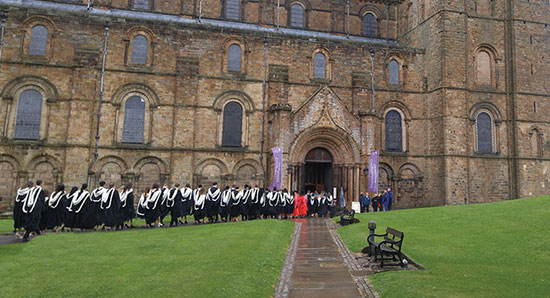
When a successful business executive — I’ll call him Jack — was invited to join the board of his church’s regional seminary, he asked me for advice. Should he or shouldn’t he accept?
The school was in a tailspin due to decreasing enrollment and diminishing support from its denomination. To counter the situation, it had shifted its emphasis away from its M.Div. program and had labeled itself “multidenominational” to attract students from other faith traditions who were interested in ministry beyond congregations. Those decisions had brought mixed results. An opening on the board prompted members to search for an objective voice, someone outside of traditional theological education, who was trained to take bold action. Jack got the call.
“As a businessman, a big part of what I do is to determine whether my product fits the marketplace,” Jack told me. “If we’re not producing something that people want, we should admit it. I’d approach being a seminary board member from that perspective.”
Before Jack agreed to serve, he wanted assurance that board members could face facts and initiate change. Specifically:
-
Would the seminary be willing to discuss the possible sale and relocation of its campus?
-
Did the faculty recognize that patterns of religious life are different now? Were they teaching students to minister in ways appropriate for emerging religious and community contexts?
-
Was the administration able to manage forward-looking, hopeful moves in response to the demise of more traditional approaches to theological education?
-
Could the board articulate a mission that reflected the new religious realities?
-
Was the board willing to adjust its rigid structure in favor of a more nimble approach to governance?
Corporate vs. academic governance
I cautioned Jack that if he decided to join the board he would need to make a few adjustments of his own. The transition from corporate board service to seminary board service wouldn’t be seamless. The corporate sector often sees governance as the process of controlling. A business board establishes policies, requires certain actions, directs employees, and rules with authority. If a product or service is failing, the board may make hard decisions and do whatever is necessary to re-craft the company’s approach to the market.
A seminary doesn’t operate that way. In higher education, governance is “shared,” involving the board, administration, faculty, and, to some extent, constituencies such as church bodies with formal or informal connections to the school. Students may even have the opportunity to weigh in on some issues.
Shared authority can be confusing to someone accustomed to the corporate approach. Adding to the confusion is the fact that no single, definitive, model exists. The Association of Theological Schools (ATS) simply says that “shared governance must be defined by each institution in a way that encourages all governance parties to exercise their leadership roles in appropriate ways.”
To help Jack decide if he would be an asset to the seminary or a thorn in its side, I offered him this primer on shared governance.
Assigning appropriate roles
Essential to the success of shared governance are participants’ respect for each other, good communication within and among the groups, and a clear understanding of the distinct roles that the board, administration, and faculty play. Shared governance does not mean that each group has an equal voice on every issue.

Board: This is the entity with ultimate responsibility for the institution, its mission, and its resources. The board appoints committees, determines responsibilities, assesses data relevant to its concerns, and regularly meets and makes decisions. Board members determine how well the school’s academic programs fit the school’s mission and whether resources are sufficient to meet institutional requirements. The board directs, approves, rejects, hires, and fires, but does not micromanage. No individual board member speaks for the board as a whole.
The board’s committee structure can be a problem, especially if an overabundance of standing committees results in data siloes that impede a comprehensive understanding of issues. Some schools have just three standing committees, with most work done by time-delimited task forces or teams — groups of perhaps two trustees, two faculty, and two outsiders with expertise in a particular topic. Such a team might accept a single area of responsibility and a deadline, after which its portfolio expires. It might meet primarily via video-conference and report progress regularly to the board chair and president. In its final report, it might suggest specific actionable proposals for the board to take up at the next board meeting.
Faculty: The faculty is responsible for the educational programs of the school — to educate students in ways that embody the school’s mission. Members meet as an academic council to make recommendations to the board about the hiring of new faculty, the development or elimination of educational programs, and the particular resources required for the educational mission to succeed. The faculty speaks to the board through the dean or other authorized representatives, not as individual professors with personal passions about issues or programs.
Just as the board has a common problem — ineffective committees — so does the faculty. Most professors come to theological education via doctoral institutions that mentor their students into discrete disciplines, and the default posture for many professors is to focus on teaching and on scholarship in discrete academic fields. Because they haven’t thought much about institutional issues like governance or fundraising, or about the roles that senior administrators and boards play in a theological school, new professors may need to be oriented to a new concept — the idea that boards, administrators, and faculty have a common vocation as theological educators.
Administration: Administrators direct, manage, administer, and advance the school. They include specialists or whole departments responsible for finance, development, recruitment, education, counseling, placement, technology, and student housing. Unlike regular faculty (who often enjoy tenure or multiyear contracts), these administrators are often “at-will” employees, with the president, executive vice president, or dean overseeing performance. The president’s cabinet or leadership team moves beyond mere fiduciary concerns into strategic and generative issues, and the president usually communicates with the academic dean and the board chair weekly.
A common problem for administrators is that many of the individuals who possess the required competencies (like financial acumen or fundraising prowess) have previously practiced those skills only in secular settings. People hired from outside theological education often struggle to understand the culture of a theological school.
Governing in community
Successful shared governance depends on healthy relationships among participants who bring different expertise and points of view to the table. The board chair and the president are co-facilitators of a communal discernment process that requires board members, administrators, and faculty to fulfill their roles as they carry out their specific responsibilities. A common understanding of these roles is essential, but discernment in the context of shared governance entails all the peculiarities of personalities. Newcomers to seminary governance, especially those from the business world, need to have knowledge of the field, accept its boundaries, respect its traditions, and understand how they can contribute to its success.